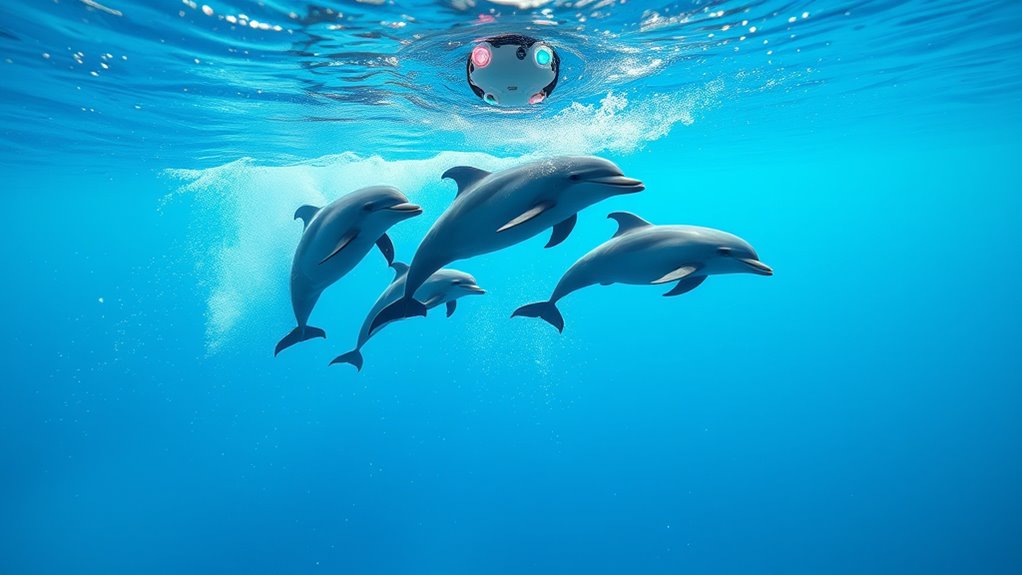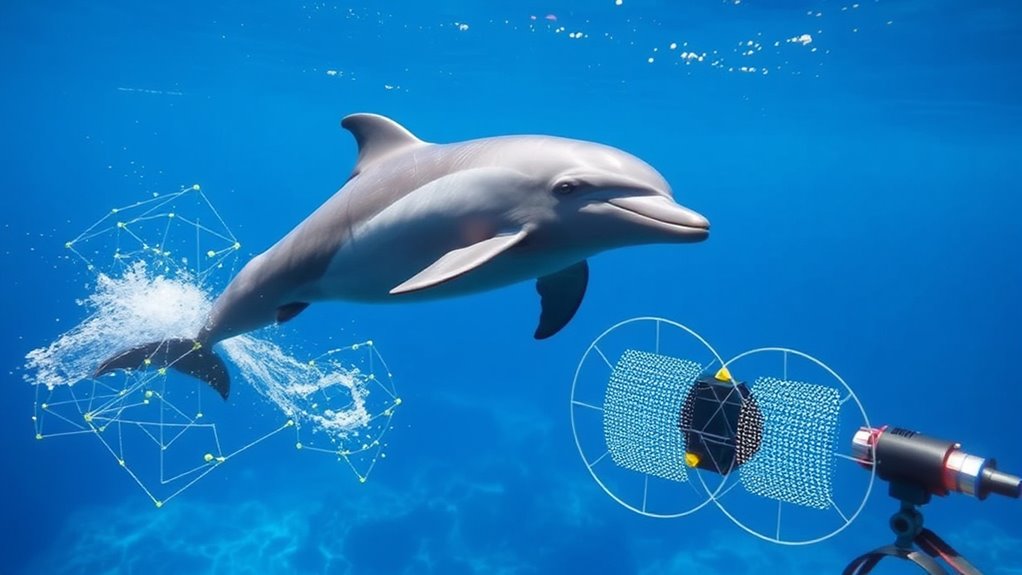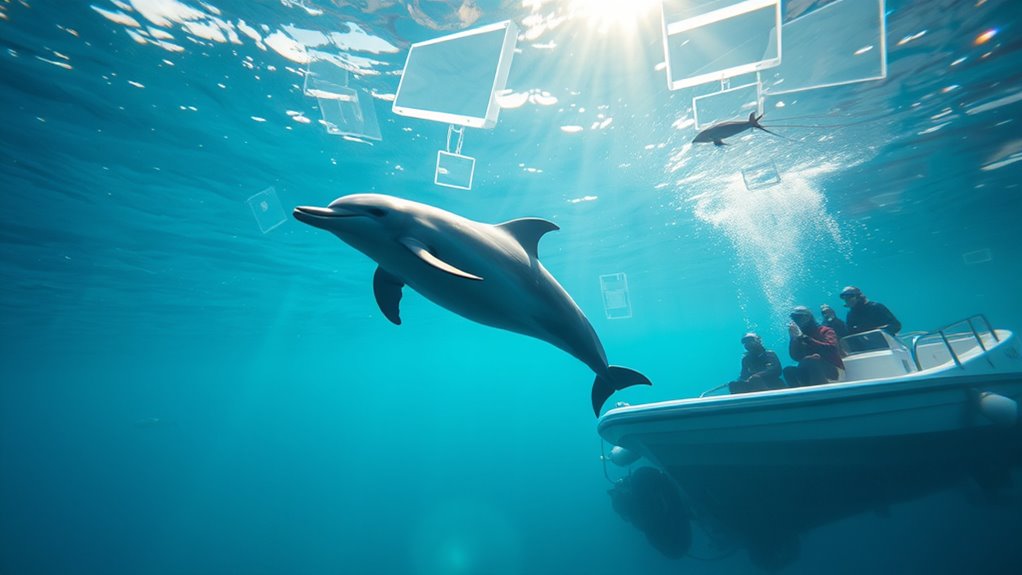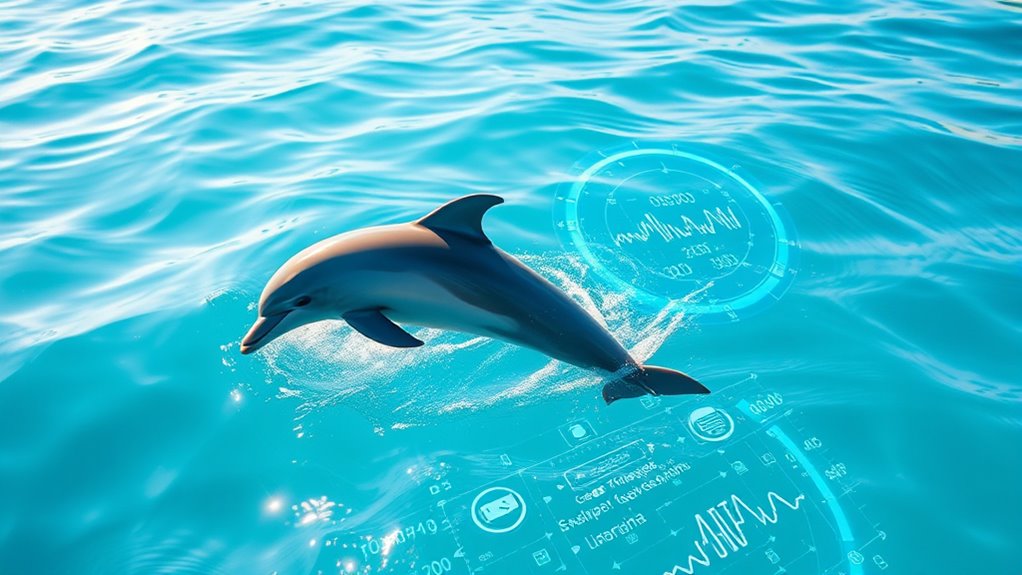AI translation is now cracking the code of dolphin speech by analyzing their complex vocalizations with advanced machine learning algorithms and high-resolution sound sensors. This technology helps identify individual calls, meanings behind social signals, and even emotional states, offering new insights into dolphin behavior and communication. As you explore further, you’ll discover how these breakthroughs are transforming marine research, conservation efforts, and our understanding of these intelligent marine mammals.
Key Takeaways
- AI analyzes complex dolphin vocalizations to identify patterns, individual signatures, and social signals with high accuracy.
- Machine learning models interpret sounds like whistles and clicks, revealing meanings related to social and environmental cues.
- Real-time translation systems facilitate understanding dolphin communications, enhancing human-dolphin interactions.
- Ethical frameworks ensure AI technologies respect dolphin welfare and prevent social disruption during research.
- Advances in acoustic analysis and neural networks are progressively decoding dolphin language, uncovering their social and cognitive complexities.
The Complexity of Dolphin Communication

Dolphins communicate with a level of complexity that continues to surprise scientists. You might think their sounds are simple whistles or clicks, but they actually convey detailed messages within intricate social structures. Dolphins form tight-knit groups with specific roles, and their communication helps coordinate hunting, protect young, and maintain social bonds. This sophisticated system influences their behavior, allowing them to adapt to changing environments. Understanding these interactions reveals how dolphin communication impacts the broader marine ecosystem. Their calls can signal danger, locate prey, or warn others, shaping ecological dynamics. Recognizing the complexity of dolphin social structures highlights just how essential their communication is, not only for individual survival but also for maintaining the balance within their marine habitat.
How Artificial Intelligence Is Making a Difference

Artificial intelligence is revolutionizing how researchers decode dolphin communication by analyzing complex sound patterns with unprecedented accuracy. This breakthrough highlights dolphin intelligence, revealing nuanced social signals and behaviors. AI’s capabilities enable: 1. Precise pattern recognition in dolphin vocalizations. 2. Identification of individual dolphins through unique sound signatures. 3. Insights into dolphin social structures and interactions. 4. Ethical considerations ensuring AI applications respect dolphin welfare. Additionally, understanding these communication patterns can foster appreciation for the father-daughter bond and other complex social relationships in the animal kingdom.
The Technology Behind Dolphin Language Translation

Advancements in machine learning algorithms and signal processing techniques form the backbone of dolphin language translation technology. By analyzing acoustic signals, researchers tap into dolphin intelligence, decoding complex vocalizations with precision. Acoustic analysis allows the system to identify patterns, frequencies, and variations in dolphin sounds, revealing meaningful communication cues. Machine learning models process vast amounts of acoustic data, learning to distinguish between different types of whistles, clicks, and burst pulses. These models adapt over time, improving translation accuracy as they recognize subtle nuances. High-resolution sensors capture sound waves underwater, feeding data into algorithms trained specifically for dolphin vocalizations. This combination of acoustic analysis and advanced algorithms enables real-time translation, bringing us closer to understanding dolphin communication in ways once thought impossible. Additionally, ongoing research emphasizes the importance of data privacy challenges in safeguarding sensitive acoustic data collected during these studies.
Breakthroughs in Machine Learning for Marine Mammals

Recent breakthroughs in machine learning are revolutionizing how we interpret marine mammal communications, enabling more accurate and nuanced understanding of their complex vocalizations. These advances help uncover how dolphins transmit cultural knowledge and strengthen social bonds. You can now explore:
Recent machine learning breakthroughs enhance understanding of dolphin vocalizations and social behaviors.
- How algorithms detect patterns in vocalizations linked to cultural transmission, revealing learned behaviors.
- The role of machine learning in mapping social bonding signals within dolphin groups.
- Enhanced ability to distinguish individual calls, aiding studies of social hierarchy.
- The development of models that interpret vocal exchanges, providing insights into their social dynamics. These innovations deepen our understanding of how marine mammals share knowledge and maintain cohesion, highlighting the importance of machine learning in decoding their sophisticated communication systems. Color accuracy can also be improved through advanced algorithms, leading to more realistic and emotionally engaging visualizations.
Insights Gained From Decoding Dolphin Vocalizations

Decoding dolphin vocalizations has yielded remarkable insights into their social lives and behaviors. By analyzing acoustic patterns, researchers have uncovered complex communication systems that reveal group dynamics, mating rituals, and alert signals. These patterns suggest dolphins possess advanced cognitive abilities, enabling them to share detailed information and coordinate activities. Additionally, understanding these vocalizations enhances our appreciation of dolphin social intelligence and their capacity for problem-solving.
Implications for Marine Research and Conservation

With AI translating dolphin sounds, you can gain deeper insights into their behaviors and social structures. This understanding helps shape more effective conservation strategies that address their specific needs. Additionally, analyzing their communication patterns can lead to the development of more accurate identification methods, further enhancing protection efforts. As a result, your efforts to protect marine life become more targeted and impactful.
Enhanced Behavioral Insights
The ability of AI translation to interpret dolphin speech opens new avenues for understanding their behavior more accurately. It reveals insights into their cognitive evolution and acoustic ecology, shedding light on how they communicate complex ideas. With this technology, you can explore:
- How dolphins coordinate group behaviors and social structures
- Their responses to environmental changes and human activity
- Nuances in individual communication patterns revealing personalities
- The development of their cognitive skills through language complexity
- The impact of operating hours on their daily routines and interactions
Improved Conservation Strategies
Deciphering the secrets of dolphin communication through AI translation offers powerful tools for enhancing conservation efforts. By understanding dolphin intelligence and acoustic signaling, you can better identify stress signals, mating calls, and social bonds. This insight helps you develop targeted strategies to protect critical habitats and reduce human disturbances. AI-driven translation enables real-time monitoring, allowing swift responses to threats like pollution or boat traffic. You can prioritize conservation zones based on dolphin communication patterns, improving their long-term survival. Additionally, understanding the acoustic signals can inform the development of more effective noise mitigation techniques to minimize human impact.
The Future of Human-Dolphin Interactions

As AI improves, you’ll see more effective ways to communicate with dolphins, opening new possibilities for understanding and cooperation. However, you’ll also face important ethical questions about how far this interaction should go. Balancing technological progress with moral responsibility will shape the future of human-dolphin relationships.
Enhanced Communication Strategies
Advancements in AI translation technology are opening new possibilities for enhancing communication between humans and dolphins. These tools foster cross-species empathy and cultural exchange, deepening understanding. To optimize this, consider:
- Developing personalized learning programs that adapt to individual dolphin communication styles
- Creating shared symbols or gestures to bridge language gaps
- Incorporating emotional recognition to interpret dolphin responses accurately
- Facilitating immersive experiences that promote mutual curiosity and trust
- Leveraging neural networks to improve the accuracy and contextual understanding of dolphin speech patterns
These strategies enable more meaningful interactions, breaking down barriers and fostering a sense of connection. As communication improves, humans gain insight into dolphin perspectives, enriching our appreciation of their complex social lives. This collaborative approach paves the way for more profound, respectful relationships rooted in understanding and empathy.
Ethical Considerations Emerging
While AI translation tools open exciting possibilities for understanding dolphins, they also raise critical ethical questions about human responsibilities and the potential impacts on marine life. One major concern is dolphin privacy; accessing their communications could infringe on their natural behaviors and autonomy. Ethical dilemmas emerge around whether humans should intervene or interpret dolphin conversations, risking misrepresentation or harm. You must consider if translating dolphin sounds might inadvertently exploit or stress them, disrupting their social structures. As technology advances, it’s essential to develop guidelines that respect dolphin rights and prioritize their well-being. Balancing scientific curiosity with ethical integrity ensures that your efforts contribute positively without compromising marine life’s natural dignity.
Frequently Asked Questions
Can AI Translation Accurately Interpret Dolphin Emotions?
You might wonder if AI translation can accurately interpret dolphin emotions. While AI analyzes dolphin syntax and emotional cues, it still faces challenges understanding the full context behind their sounds. You need to recognize that dolphins communicate complex feelings through subtle variations in their vocalizations and body language. Although AI makes strides in decoding these signals, it’s not yet perfect at capturing the depth of dolphin emotions, requiring ongoing refinement.
Are There Ethical Concerns in Translating Dolphin Speech?
Imagine eavesdropping on dolphins’ secrets, turning their joyful clicks into gossip. You might think it’s harmless, but you’d ignore the privacy concerns and ecological impacts. Transmitting dolphin speech raises ethical issues, like disrupting their natural behaviors or invading their privacy. As you decode their conversations, remember: respecting animal autonomy matters, and the ocean’s delicate balance shouldn’t be sacrificed for human curiosity. Ethics must guide this aquatic translation adventure.
How Does Dolphin Vocabulary Vary Across Different Regions?
You notice that dolphin vocabulary varies across regions through vocal variation and regional dialects. These differences can include unique whistles and clicks specific to each area, reflecting local social groups. Such regional dialects help dolphins identify each other and maintain social bonds. By studying these vocal variations, you can better understand dolphin communication and how environmental or social factors influence their language across different regions.
Will This Technology Be Used for Dolphin Conservation Efforts?
You might wonder if this technology will aid dolphin conservation efforts. It certainly can, by monitoring their marine habitat, understanding their needs, and reducing harmful human interaction. By translating dolphin communication, we gain insights into their well-being, behaviors, and threats. This understanding empowers us to protect their environment and foster a respectful coexistence, ensuring dolphins thrive in the wild. Ultimately, it’s about using technology to bridge gaps and support conservation.
Can AI Translate Other Marine Animals’ Communications Effectively?
You wonder if AI can effectively translate other marine animals’ communications. With advancements in understanding marine mammal communication and underwater acoustics, AI shows promise in decoding the complex sounds of whales, seals, and other species. By analyzing patterns and frequencies, AI can help us better interpret their messages. While still in early stages, this technology could revolutionize marine biology, aiding in conservation and deepening our connection with underwater life.
Conclusion
Now, with AI cracking dolphin speech, you’re on the brink of a communication revolution that’s more astonishing than anything you’ve ever imagined. Imagine understanding dolphins as if they’re speaking directly to you—breaking down barriers that once seemed insurmountable. This breakthrough isn’t just a leap; it’s a giant leap for marine science, opening doors to endless discoveries and transforming how you connect with the ocean’s most brilliant creatures. The future’s voice is calling—are you ready to listen?










